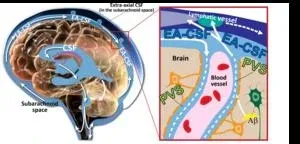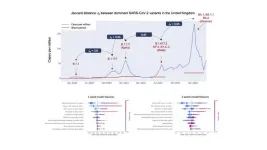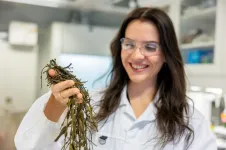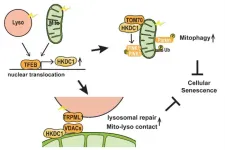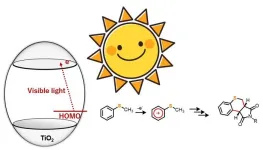(Press-News.org)
Could healthy fats found in nuts and fish slow the progression of potentially deadly lung scarring known as pulmonary fibrosis and delay the need for lung transplants?
UVA pulmonary researchers looked at the association between blood-plasma levels of omega-3 fatty acids – the heart-healthy fats found in foods such as salmon and flaxseeds – and the progression of pulmonary fibrosis, as well as how long patients could go without needing a transplant. The researchers found that higher levels of omega-3 were associated with better lung function and longer transplant-free survival.
While more research is needed, the researchers say their findings warrant clinical trials to determine if interventions that raise omega-3 levels could be a useful tool to improve outcomes for patients with pulmonary fibrosis and other chronic lung diseases.
“We found that higher levels of omega-3 fatty acids in the blood, which reflects several weeks of dietary intake, were linked to better lung function and longer survival,” said researcher John Kim, MD, a pulmonary and critical care expert at UVA Health and the University of Virginia School of Medicine. “Our findings suggest omega-3 fatty acids might be a targetable risk factor in pulmonary fibrosis.”
Omega-3 and Pulmonary Fibrosis
Omega-3 fatty acids have already been linked to a host of health benefits. Studies have suggested, for example, that they may lower the risk of heart disease, stroke-causing blood clots, breast cancer and other cancers, Alzheimer’s disease and dementia.
Kim and his colleagues wanted to determine if omega-3s could play a protective role in interstitial lung disease, a group of chronic lung diseases that can lead to pulmonary fibrosis. A growing problem around the world, pulmonary fibrosis is an irreversible condition that leaves the lungs unable to exchange oxygen and carbon dioxide properly. This can cause patients to become short of breath, weak, unable to exercise and a host of other symptoms. Smoking is a major risk factor.
The researchers looked at anonymized data on patients with interstitial lung disease collected in the Pulmonary Fibrosis Foundation Registry, as well as information volunteered by patients at UVA Health and the University of Chicago.
In total, the scientists reviewed information on more than 300 people with interstitial lung disease. Most were men (pulmonary fibrosis is more common in men than women), and most suffered from “idiopathic” pulmonary fibrosis, one of the conditions that fall under the banner of interstitial lung disease.
The researchers found that higher levels of omega-3 fatty acids in the blood plasma were associated with better ability to exchange carbon dioxide and longer survival without the need for a lung transplant. This did not vary much regardless of smoking history or whether the patients had cardiovascular disease.
“Higher levels of omega-3 fatty acids were predictive of better clinical outcomes in pulmonary fibrosis,” Kim said. “These findings were consistent whether you had a history of cardiovascular disease, which suggests this may be specific to pulmonary fibrosis.”
The doctors say additional research is needed to understand just how omega-3s could be having this protective benefit. They are calling for clinical trials and more mechanistic studies to obtain additional insights and determine if omega-3 fatty acid drugs or dietary changes could improve patient outcomes.
“We need further research to determine if there are specific omega-3 fatty acids that may be beneficial and, if so, what are their underlying mechanisms,” Kim said. “Similar to other chronic diseases, we hope to determine whether nutrition related interventions can have a positive impact on pulmonary fibrosis.”
Findings Published
The researchers have published their findings in the scientific journal Chest. The research team consisted of Kim, Shwu-Fan Ma, Jennie Z. Ma, Yong Huang, Catherine A. Bonham, Justin M. Oldham, Ayodeji Adegunsoye, Mary E. Strek, Kevin R. Flaherty, Emma Strickland, Inemesit Udofia, Joshua J. Mooney, Shrestha Ghosh, Krishnarao Maddipati and Imre Noth. Noth has received personal fees from Boehringer Ingelheim, Genentech and Confo unrelated to the work. He is also seeking to patent transcriptomic prognostics in idiopathic pulmonary fibrosis. A full list of the authors’ disclosures is included in the paper.
Kim’s work was supported by a Pulmonary Fibrosis Foundation Scholars Award and grant K23-HL-150301 from the National Institutes of Health’s National Heart, Lung and Blood Institute (NHLBI). The research was also supported in part by the National Center for Research Resources, grant S10RR027926.
To keep up with the latest medical research news from UVA, subscribe to the Making of Medicine blog at http://makingofmedicine.virginia.edu.
END
An AI model can predict which SARS-CoV-2 variants are likely to cause new waves of infection. Current models used to predict the dynamics of viral transmission do not predict variant-specific spread. Retsef Levi and colleagues studied what factors could shape the viral spread based on analysis of 9 million SARS-CoV-2 genetic sequences collected by the Global Initiative on Sharing Avian Influenza Data (GISAID) from 30 countries, along with data on vaccination rates, infection rates, and other factors. The patterns that emerged from this analysis ...
Norway’s exports products derived from from tangle kelp (Laminoria hyperborea) and knotted kelp (Ascophyllum nodosu) to the tune of more than NOK 1 billion a year. The industry mainly extracts alginate from kelp, which is used in over 600 different products as diverse as paint, soft serve ice cream, sauces, bandages, nappies, acid reflux medicine and material for encapsulating cells and medicine. However, the market is far from saturated.
“Alginate is becoming a scarce commodity on the global market. There are great opportunities here if we could cultivate more kelp that yielded alginate of good enough quality,” says Finn Aachmann, a professor at the Norwegian ...
Our memories are rich in detail: we can vividly recall the color of our home, the layout of our kitchen, or the front of our favorite café. How the brain encodes this information has long puzzled neuroscientists.
In a new Dartmouth-led study, researchers identified a neural coding mechanism that allows the transfer of information back and forth between perceptual regions to memory areas of the brain. The results are published in Nature Neuroscience.
Prior to this work, the classic understanding of brain organization was that perceptual regions of the brain represent the world "as it is," with the ...
Just like a doctor adjusts the dose of a medication to the patient’s needs, the expression of therapeutic genes, those modified in a person to treat or cure a disease via gene therapy, also needs to be maintained within a therapeutic window. Staying within the therapeutic window is important as too much of the protein could be toxic, and too little could result in a small or no therapeutic effect.
Although the principle of therapeutic window has been known for a long time, there has been no strategy to implement it safely, limiting the potential applications of gene therapy in the clinic. ...
Embargoed for release until 5:00 p.m. ET on Monday 1 January 2024
Annals of Internal Medicine Tip Sheet
@Annalsofim
Below please find summaries of new articles that will be published in the next issue of Annals of Internal Medicine. The summaries are not intended to substitute for the full articles as a source of information. This information is under strict embargo and by taking it into possession, media representatives are committing to the terms of the embargo not only ...
Osaka, Japan – Just as healthy organs are vital to our well-being, healthy organelles are vital to the proper functioning of the cell. These subcellular structures carry out specific jobs within the cell, for example, mitochondria power the cell and lysosomes keep the cell tidy.
Although damage to these two organelles has been linked to aging, cellular senescence, and many diseases, the regulation and maintenance of these organelles has remained poorly understood. Now, researchers at Osaka University have identified a protein, HKDC1, that plays a key role in maintaining these two organelles, thereby acting to prevent ...
Heterocyclic compounds are organic molecules with a ring structure comprising at least two or more elements. In most cases, these rings are composed of carbon atoms along with one or more other elements such as nitrogen, oxygen, or sulfur. They are highly sought-after as raw materials in the chemical and pharmaceutical industry, owing to their versatility and excellent physiological activities. While several methods are available for synthesizing these compounds, most of them involve high temperature and pressure conditions, or the use of precious ...
A new study published in Addiction has found that cytisine, a low-cost, generic stop-smoking aid that has been used in eastern Europe since the 1960s, increases the chances of successful smoking cessation by more than two-fold compared with placebo and may be more effective than nicotine replacement therapy. It has a benign safety profile, with no evidence of serious safety concerns. Sounds perfect for your New Year resolution, doesn’t it? But there’s a catch: Cytisine is not licensed or marketed in most countries outside of central and eastern Europe, ...
Travel deep enough below Earth’s surface or inside the center of the Sun, and matter changes on an atomic level.
The mounting pressure within stars and planets can cause metals to become nonconducting insulators. Sodium has been shown to transform from a shiny, gray-colored metal into a transparent, glass-like insulator when squeezed hard enough.
Now, a University at Buffalo-led study has revealed the chemical bonding behind this particular high-pressure phenomenon.
While it’s been theorized that high pressure essentially squeezes sodium’s electrons out into the spaces between atoms, researchers’ quantum chemical ...
WASHINGTON—The Endocrine Society, the world’s oldest and largest professional medical society devoted to the study and treatment of hormone-related conditions, applauds Governor Mike Dewine’s veto of a proposed Ohio law that would have banned gender-affirming care for minors. The bill he vetoed contradicts mainstream medical practice and scientific evidence and would have taken medical decision-making out of the hands of families and their physicians and instead relied upon government officials.
More ...

